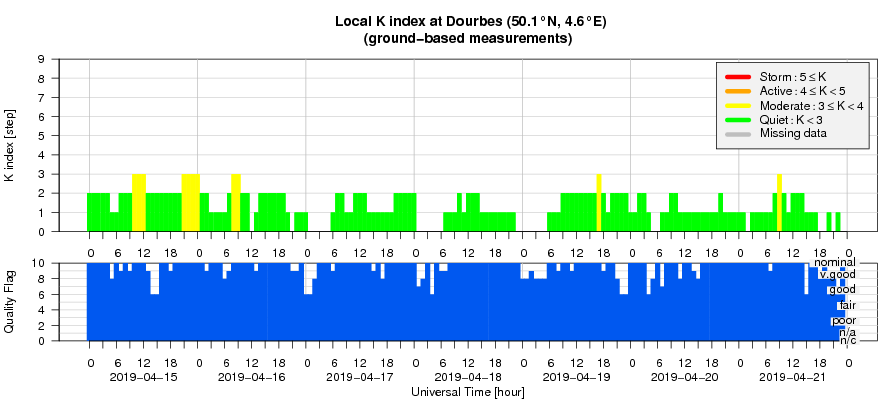- Table of Content
- 1.Let us introdu...
- 2.PROBA2 Observa...
- 3.Review of sola...
- 4.The Internatio...
- 5.Review of geom...
- 6.Geomagnetic Ob...
- 7.The SIDC space...
- 8.Review of iono...
2. PROBA2 Observations (15 Apr 2019 - 21 Apr 2019)
3. Review of solar activity
4. The International Sunspot Number by SILSO
5. Review of geomagnetic activity
6. Geomagnetic Observations at Dourbes (15 Apr 2019 - 21 Apr 2019)
7. The SIDC space weather Briefing
8. Review of ionospheric activity (15 Apr 2019 - 21 Apr 2019)
Let us introduce you to the new ISES director
On April 16, the new director for ISES, International Space Environment Service (http://www.spaceweather.org) was announced by the resigning director.
Terry Onsager: 'I am pleased to announce that as a result of our ISES-wide vote, Jesse Andries, RWC Belgium, is our new ISES Director. Jesse is dedicated to the operational mission of the ISES Centers, and he brings a deep knowledge of space weather and a strong enthusiasm for science and services. Please join me in congratulating Jesse.
Let me also say that it has been a great pleasure serving as ISES Director. We have an important mission with many exciting challenges. It has been fabulous working with everyone. Thank you!'
Go, Jesse, Go!

PROBA2 Observations (15 Apr 2019 - 21 Apr 2019)
Solar Activity
Solar flare activity remained very low during the week.
In order to view the activity of this week in more detail, we suggest to go to the following website from which all the daily (normal and difference) movies can be accessed: http://proba2.oma.be/ssa.
This page also lists the recorded flaring events.
A weekly overview movie can be found here (SWAP week 473): http://proba2.oma.be/swap/data/mpg/movies/weekly_movies/weekly_movie_2019_04_15.mp4.
Details about some of this week's events, can be found further below.
If any of the linked movies are unavailable they can be found in the P2SC movie repository here: http://proba2.oma.be/swap/data/mpg/movies/
Saturday Apr 20
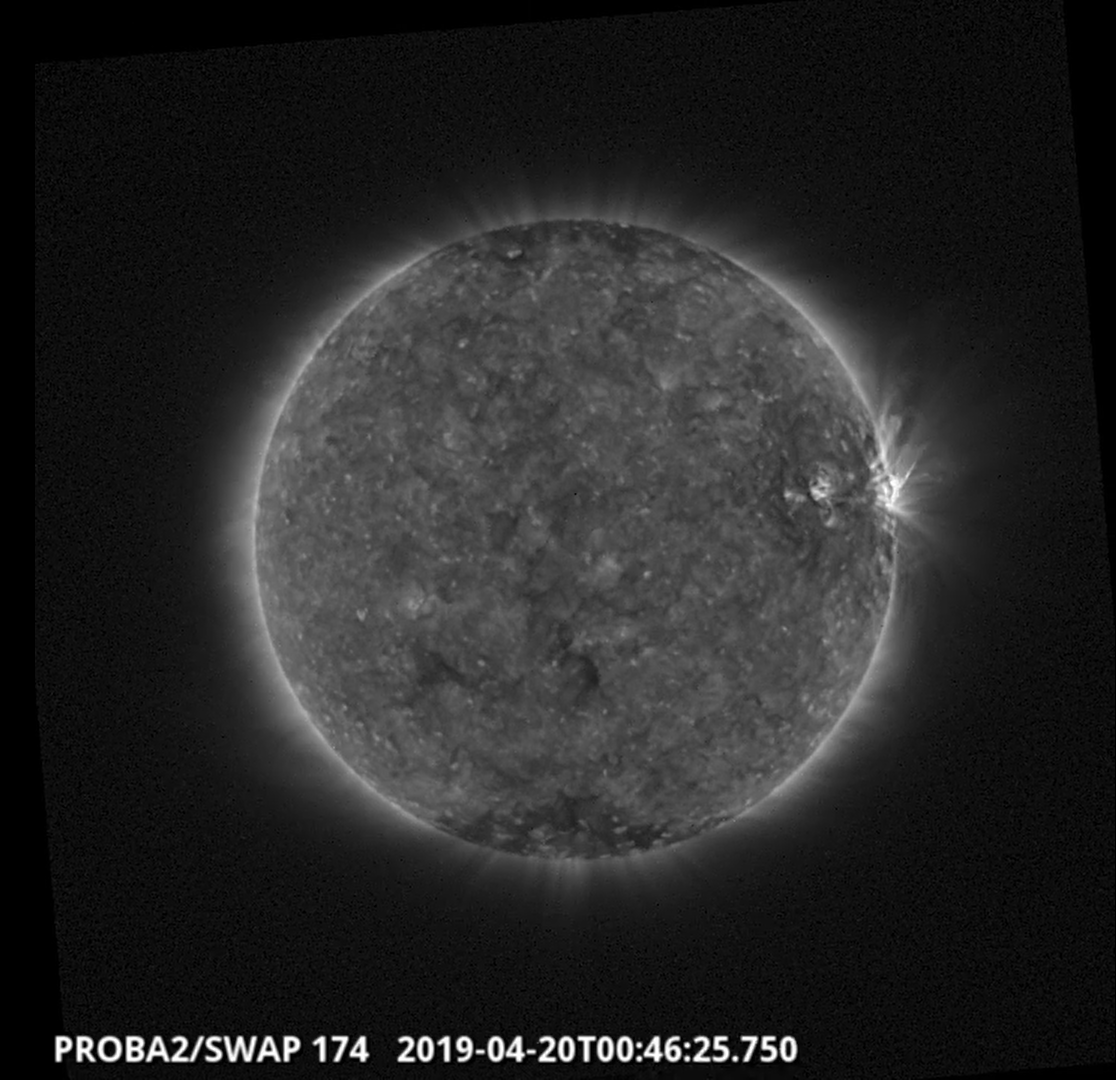
The largest flare of the week (B8.1), associated with NOAA AR 2738, was observed by SWAP and LYRA on 2019-Apr-20 and is visible on the west limb of the Sun in the SWAP image above taken at 00:46 UT.
Find a movie of the event here (SWAP movie): http://proba2.oma.be/swap/data/mpg/movies/20190407_swap_movie.mp4
Review of solar activity
Solar activity was at very low levels. NOAA 2738 was the largest sunspot region on the solar disk, rounding the west limb on 19 April. It produced several B-class flares, with the strongest event of the week a B8 flare peaking at 00:50UT on 20 April. The other region, NOAA 2739, was small and quiet and decayed before rounding the west limb.

None of the observed coronal mass ejections (CMEs) had an earth-directed component. The greater than 10 MeV proton flux was at nominal levels.
A diffuse extension from the positive polarity polar coronal hole (CH) transited the central meridian (CM) on 15-16 April, and a negative polarity equatorial CH was transiting the CM on 19-21 April.
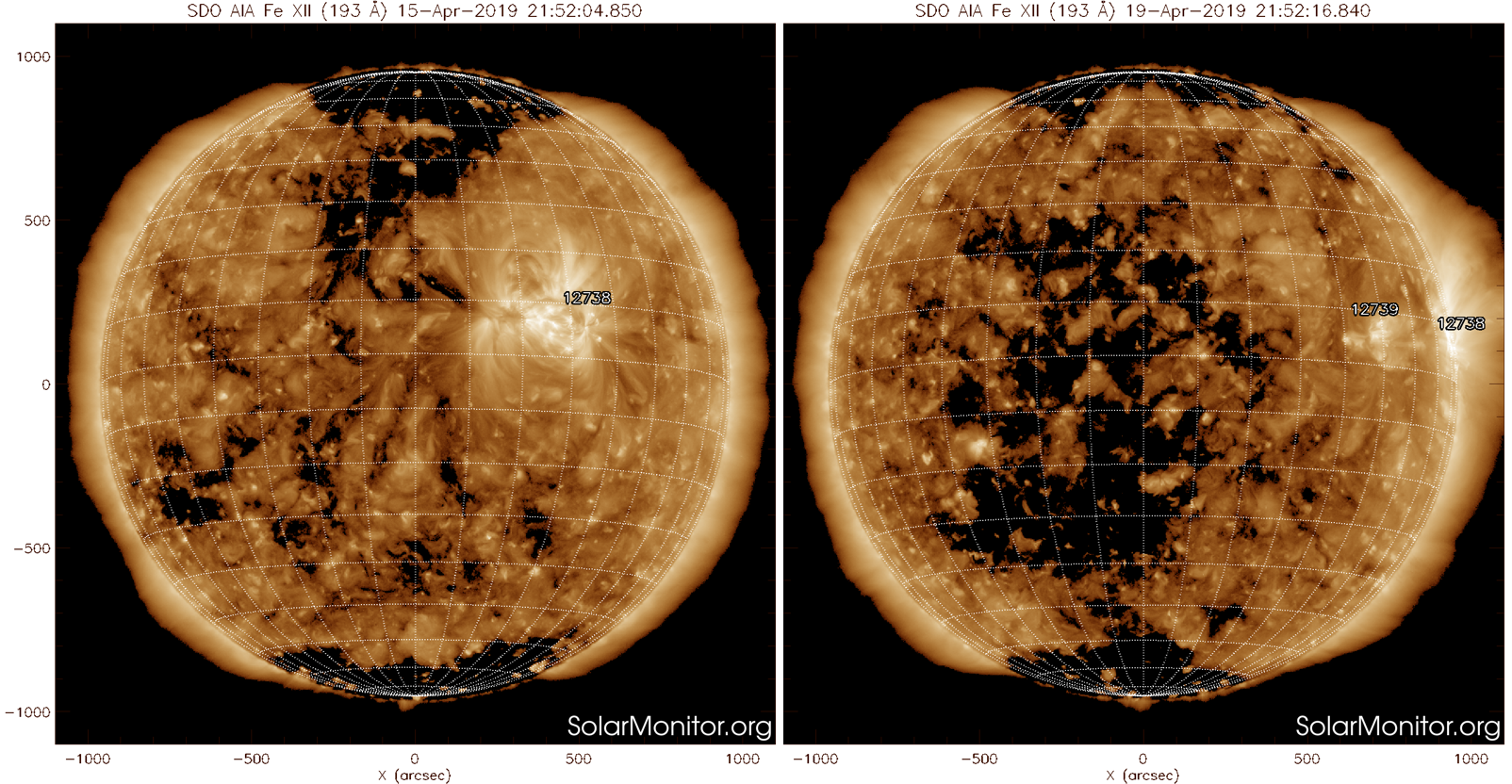
The International Sunspot Number by SILSO
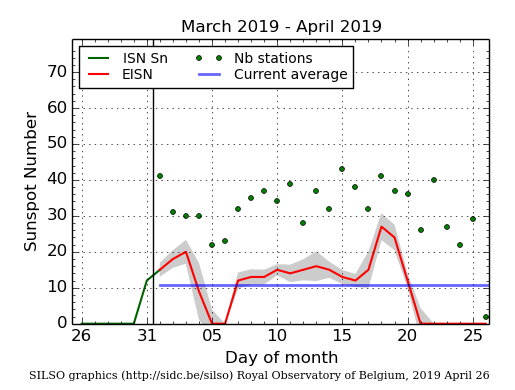
The daily Estimated International Sunspot Number (EISN, red curve with shaded error) derived by a simplified method from real-time data from the worldwide SILSO network. It extends the official Sunspot Number from the full processing of the preceding month (green line). The plot shows the last 30 days (about one solar rotation). The horizontal blue line shows the current monthly average, while the green dots give the number of stations included in the calculation of the EISN for each day.
Review of geomagnetic activity
Solar wind at the earth environment was at nominal levels. Solar wind speed started the week with values near 310 km/s, increasing to about 400 km/s by 16 April, decreasing to a low of 280 km/s on 18 April, then starting a gradual increase to reach 360 km/s by the end of the period. Bz varied between -6 and +6 nT (DSCOVR). The direction of the IMF switched from towards (negative sector) to mostly away from the Sun (positive sector) early on 19 April.
Quiet to unsettled geomagnetic conditions were observed throughout the week (Kp and K Dourbes), with most of the unsettled intervals occurring on 15 and 16 April.
The SIDC space weather Briefing
The Space Weather Briefing presented by the forecaster on duty from April 14 to April 21. It reflects in images and graphs what is written in the Solar and Geomagnetic Activity report.
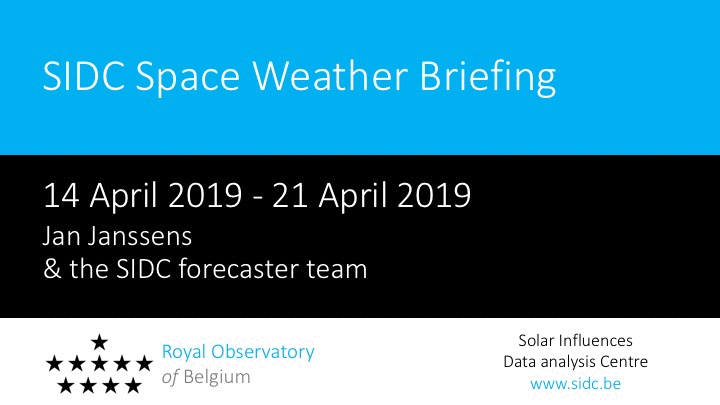
The pdf-version: http://www.stce.be/briefings/20190422_SWbriefing.pdf
The automatically running presentation: http://www.stce.be/briefings/20190422_SWbriefing.ppsm
Review of ionospheric activity (15 Apr 2019 - 21 Apr 2019)

The figure shows the time evolution of the Vertical Total Electron Content (VTEC) (in red) during the last week at three locations:
a) in the northern part of Europe(N61°, 5°E)
b) above Brussels(N50.5°, 4.5°E)
c) in the southern part of Europe(N36°, 5°E)
This figure also shows (in grey) the normal ionospheric behaviour expected based on the median VTEC from the 15 previous days.
The VTEC is expressed in TECu (with TECu=10^16 electrons per square meter) and is directly related to the signal propagation delay due to the ionosphere (in figure: delay on GPS L1 frequency).
The Sun's radiation ionizes the Earth's upper atmosphere, the ionosphere, located from about 60km to 1000km above the Earth's surface.The ionization process in the ionosphere produces ions and free electrons. These electrons perturb the propagation of the GNSS (Global Navigation Satellite System) signals by inducing a so-called ionospheric delay.
See http://stce.be/newsletter/GNSS_final.pdf for some more explanations ; for detailed information, see http://gnss.be/ionosphere_tutorial.php
